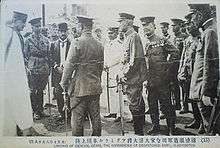Otani Kikuzo
Otani Kikuzo (大谷 喜久蔵, Ōtani Kikuzō, 1856–1923) was a general in the Imperial Japanese Army. Otani participated in the First Sino-Japanese War, Russo-Japanese War, World War I and the Russian Civil War. During the course of the latter he commanded the Vladivostok Expeditionary Force and became the formal commander of the Allied Siberian Intervention. He was elevated to baron upon his retirement in 1920.
Otani Kikuzo | |
|---|---|
 Otani Kikuzo | |
| Born | 4 February 1856 Obama Domain, Echizen Province |
| Died | 26 November 1923 (aged 67) |
| Allegiance | |
| Service/ | |
| Years of service | 1871-1920 |
| Rank | |
| Battles/wars | First Sino-Japanese War Russo-Japanese War World War I Russian Civil War
|
Military career
Kikuzo Otani was born in 1856. He began his military career by enlisting into an infantry regiment. He was promoted to lieutenant in 1883, captain in 1886 and major in 1892. Two years later he joined the Imperial Japanese Army General Staff Office in Hiroshima where he served during the course of the First Sino-Japanese War. In 1897, he reached the rank of colonel. In 1902, he was elevated to major general.[1] During the course of the Russo-Japanese War he commanded a battalion in the 4th Army.[2] In the aftermath of the Japanese entry into World War I and the subsequent Japanese occupation of Tsingtao Kikuzo became the commander of the city's garrison.[1]

_pic22_-_The_leaders_of_the_Japanese_Forces_in_Siberia%2C_General_Kikuyo_Otani_and_Lieut.-General_Mitsuya.jpg)
In 1918, Japan joined its allies in a joint intervention into the Russian Civil War in support of the White movement. Otani was appointed head of the Japanese expeditionary force with Yui Mitsue as the Chief of Staff. The Vladivostok Expeditionary Force was 60,000 men strong, comprising three divisions including the 12th Division and the 5th Division.[1] On 12 August, Japanese forces departed from the Tokyo railway station for Hiroshima, where they were to board ships destined for Vladivostok.[2] Following Vladivostok's occupation Otani became the formal commander of the Allied Siberian Intervention. In April 1920, Otani ordered the Allied troops to cut off eastern Transbaikal from the Bolshevik controlled Far Eastern Republic thus creating the Chita holdup.[1]
In 1919, he was appointed inspector general at the Inspectorate General of Military Training. He retired from active service a year later and was elevated to baron. On 1 November 1920, Otani was awarded the Order of the Golden Kite for his role in World War I and the Siberian intervention. Kikuzo Otani died in 1923.[1]
Honours
| Order of the Golden Kite | 1920 | |
| Order of the Paulownia Flowers | 1920 | |
| Knight Grand Cross, Order of St Michael and St George (UK) | ||
| Grand Officer, Order of Saints Maurice and Lazarus (Italy) | ||
| Grand Cross, Order of the Star of Romania (Romania) | ||
| War Merit Cross (Italy) | ||
| Médaille militaire (France) | 1919 | |
| Czechoslovak War Cross 1918 (Czechoslovakia) |
References
- Petin 2015, p. 244.
- Sarkisov 2017, pp. 16–18.
Further reading
- Petin, Dimitry (2015). "Документы Временного правительства автономной Сибири о хождении военных денег Сибирской экспедиции японских войск" [Documents of the Temporary government of autonomous Siberia regarding the circulation of Japanese military currency]. Modern history of Russia (in Russian). Saint Petersburg State University. 14 (3): 236–246. Retrieved 8 May 2018.CS1 maint: ref=harv (link)
- Sarkisov, Konstantin (2017). "Японская интервенция в Сибири. Прелюдия (Часть 2)" [Japanese intervention in Siberia. Prelude (Part 2)]. Yaponskie Isledovania (in Russian). Russian Academy of Sciences. 4 (1): 5–18. doi:10.24411/2500-2872-2017-00025. Retrieved 8 May 2018.CS1 maint: ref=harv (link)
- Ando, Yoshio, ed. (1993). 陸軍大将大谷喜久蔵の年譜 [A History of the Army General Kikuzo Otani] (in Japanese).
| Military offices | ||
|---|---|---|
| Preceded by Kamio Mitsuomi |
Military Governor of Tsingtao 24 May 1915–6 August 1917 |
Succeeded by Hongo Fusataro |
| New creation | Commander, Vladivostok Expeditionary Force 29 August 1918–26 August 1919 |
Succeeded by Oi Shigemoto |
| Preceded by Ichinohe Hyoe |
Inspector-General of Military Training 26 August 1919–28 December 1920 |
Succeeded by Akiyama Yoshifuru |